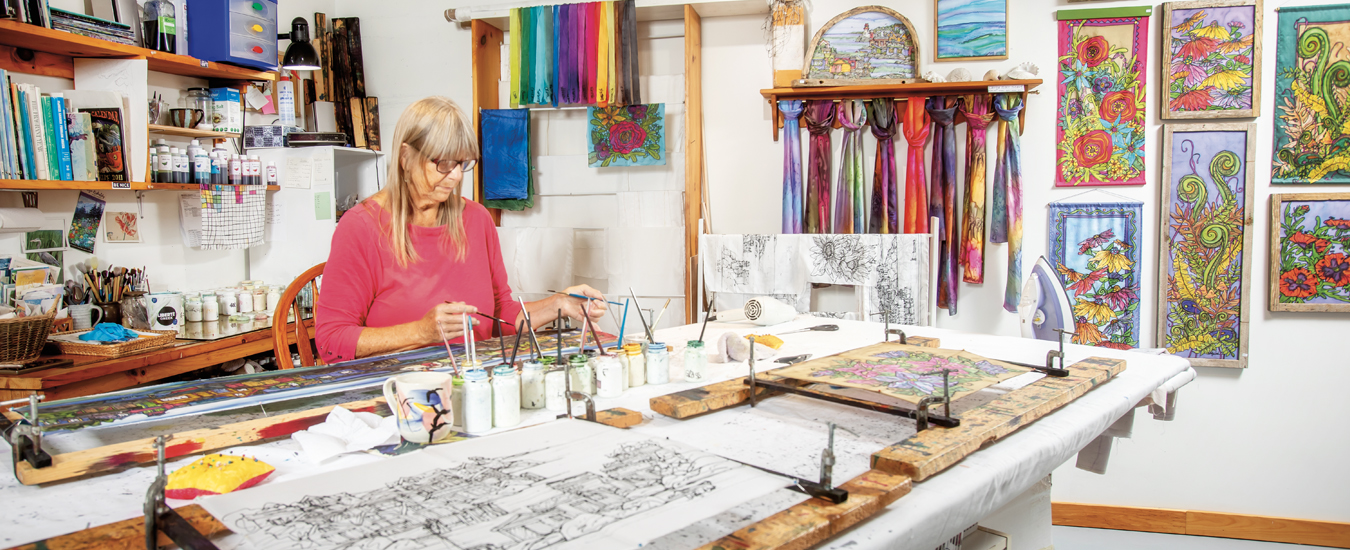Walking into Smooth as Silk, Marilyn Cook’s silk-painting studio in Sackville, N.B., is like walking into a magical fabric garden. Paintings of fishing villages, flowering plants, ferns, and birds festoon the walls. There are rainbow-hued, hand-painted silk scarves hanging on racks and pegs, and a stack of floral-themed chair mats hooked with strips of leftover silk waiting for new homes. Cook is working on a new wall-hanging of sunflowers, with stacks of unpainted silk awaiting her skills.
Born in Alliston, Ont., Cook came to the East Coast in the late 1970s to visit a friend for two weeks, and never left. Her then-friend Bill was a lobster fisherman, and she says, “his boat won me over.” She fished lobster with Bill for a few years and when they began raising a family, it was too hard to find child care that worked with the long hours of lobstering, so Cook came ashore.
Working in fish plants helped with the household budget, but Cook always liked working with her hands, and when a friend showed her how to paint on silk, “my heart said, ‘This is what you have to be doing,’” she says. Her mother was a seamstress and Cook had collected scraps of fabric and made clothing for her dolls, so it was natural for her to take up with silk. She says, “the colours that we paint with are so vibrant, and silk is such a luxurious fabric … My mother had taught me to work with my hands and how to work hard, and that helped because I’m not formally trained.”
Cook started selling her work in 1986, at local craft shows with the friend who had taught her to paint silk. She says she loved that she could now work from home in Shemogue, between Port Elgin and Cap-Pelé on New Brunswick’s Northumberland shore, where she and her family lived for years. “My first studio was upstairs in my husband’s garage where he stored his bait bags and rope and such for fishing, and it was smelly and hot in the summer and smelly and cold in the winter.”
As she got busier, she needed more studio space, and lobster seasons were picking up, so Bill built a studio for her, and then after he got out of fishing in 2017, he built their current home in Sackville, along with Cook’s well-lit and welcoming studio nestled in the garden.
Along with selling by chance or appointment, Cook supplies a handful of craft stores around the region, including the popular shop at the Sackville Tourist Bureau, and she has a website that shows her work.

Initially, Cook was painting scarves only, and after only a couple of years added wall hangings to her line. “People would say the scarves were too pretty to wear, and so I thought I should paint something for the wall,” she says. Bill makes all her frames out of recycled wooden lobster traps from around the Maritimes.
The silk itself comes from China via a company in Toronto. It comes in different weights, some of it already hemmed and fringed for scarves. Habotai silk is the heavier weight Cook uses for some designs, and she uses a thinner fabric, called pongee silk, for the salt-dyed scarves she does. One of her lines uses a silk-velvet scarf blend, which is made with rayon/silk fabric she imports from the U.S.
To paint a design, Cook first pins the silk to a board and then draws everything freehand using a bottled resist product called gutta. This material permeates the fabric and when she begins to paint, the colours stop at the resist lines. Her fabric paints are water-based and Cook describes the process of doing the designs as being like painting a watercolour, blending and applying different colours.
Once the design is done, it has to be steamed to set the dye and make it colourfast. Cook rolls up the item and steams it over a roasting pan, then hand washes each piece to remove any excess dye. To make a scarf from start to finish, logistically, is about a week, because she likes to let the material sit for a few hours in between each step.
“If I had to, I could draw, paint, and steam a design in two days,” she says, but adds that after so many years as an artist, she doesn’t work fulltime every day now. She and Bill enjoy travelling now that he is retired from fishing, and they spend part of the year on the road, where Cook works on her hooked mats made with scraps of silk.
She is also an avid gardener and during the growing seasons, takes regular breaks from her silk art to work in her live inspirations, among the sunflowers, irises, poppies and ferns that appear in her designs.
